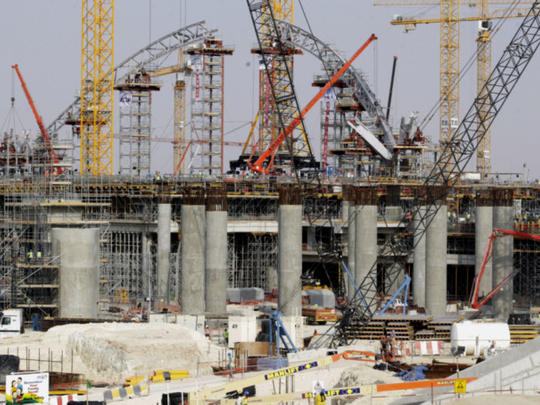
The next five years will see Abu Dhabi transform thanks to the more than $100 billion (about Dh367.3 billion) being injected into building new homes, schools, roads and other infrastructure.
As the capital of the UAE, Abu Dhabi is the centre of the country’s political, industrial and cultural activities. Its rich hydrocarbon reserves also rank Abu Dhabi as a city with one of the highest GDP per capita figures in the world.
As part of its 2030 vision, Abu Dhabi plans to expand its non-hydrocarbon sector and diversify its economy.
Raj Sahni, Founder and Chairperson of prime real estate and property developer Raj Sahni Group International, says, “Abu Dhabi Vision 2030, the development plan of the city released by the Abu Dhabi Urban Planning Council, chalks out a detailed blueprint of how the government of Abu Dhabi is preparing to place the city on the world infrastructure map. The statements, issued through the plan, stipulate land use, building structures and transportation [goals] of the city. It is planned to be a classic mix of conventional and traditional housing, keeping the local community and family structures in mind.”
From 2013 to 2017, the city will invest $30 billion in its construction and service sector development plan, particularly in the airport and rail sectors, creating more than 5,000 jobs.
In the last three months of 2013, 22,000 new homes were completed in Abu Dhabi and another 22,000 are expected to be handed over this year, according to property consultant JLL.
The company says a key trend of the past year has been the revival of projects put on hold during the downturn, estimating that another 825,000 square metres of office space will be delivered by 2015 with companies such as Abu Dhabi Islamic Bank, Finance House and Siemens set to occupy new office blocks. Key developments being restarted include Al Maryah Island, Al Reem Island, Saadiyat Island and Yas Island.
Rizwan Sajan, Chairman of Danube Building Materials, says, “In its quest to become an international investment hub, Abu Dhabi has pushed forward major construction projects in infrastructure and residential/non-residential segments. These upcoming projects will transform Abu Dhabi into a global tourist location, which, in turn, will see growth for sectors such as retail, construction and hospitality in the emirate.”
“In doing so, it is laying the foundation for a socially cohesive and economically sustainable community that preserves the emirate’s unique cultural heritage,” he says.
Infrastructure
The infrastructure sector will also receive a considerable boost. Construction is set to begin on the new 62km Abu Dhabi-Dubai highway. At the cost of Dh2.1 billion, it’s expected to be completed in 2017 and is in line with the ambitious plans of the city. The new road will ease traffic congestion on the E11, which will go up from 700 vehicles per hour at peak time to more than 12,000 vehicles in 2030.
Another key infrastructure project, the $11-billion Etihad Rail project will link Dubai, Abu Dhabi and the northern emirates and the ports of Khalifa and Jebel Ali. Around $3 billion will be invested in developing a 131km metro system. An increase in airport capacity (including the new Midfield Terminal) and port capacity are planned. About 246km of road work is also in the pipeline.
Khalifa Port will be a new port that will include an industrial zone and five industrial cities designed to attract new industries and manufacturers to the emirate.
Another big project in the pipeline is the $6.8-billion Abu Dhabi International Airport redevelopment.
With various projects to be realized over the next few years, Abu Dhabi can expect to see a lot more activity not only in its business sector but in its residential and cultural sectors as well.
Khalifa City
Work on what is slated to become Abu Dhabi’s second downtown is also set to begin soon. Around $2 billion has been earmarked for the Shaikh Zayed project, a state-of-the-art housing development, situated in a triangle between Khalifa City A, Khalifa City B and Mohammad Bin Zayed City. It will be home to about 370,000 families as well as the majority of the city’s ministries, embassies, and financial and trade institutions. The project will include an area designated for schools, entertainment and sports facilities and will be served by a network of trains, trams and pedestrian pathways.
Saadiyat island
One of the biggest projects on the horizon for Abu Dhabi is Saadiyat Island, a once uninhabited stretch of coastal desert close to Abu Dhabi’s city centre. The centrepiece of the development will be a New York University campus, a $1.3-billion Jean Nouvel-designed Abu Dhabi Louvre and the Frank Geary-designed Guggenheim. Close by will be the British Museum and Zayed National Museum designed by Norman Foster. Surrounding this will be five-star hotels and hundreds of luxury villas and apartments.
The Tourism Development and Investment Company recently awarded the long-awaited $653-million contract to build the Louvre Museum on Saadiyat Island to a consortium comprising local Arabtec Construction, Spain’s San Jose and Oger Abu Dhabi, the local affiliate of Saudi Oger.
Afreen Aslam, Managing Director of Alpen Capital, says, “The projects planned will transform Abu Dhabi into an integrated, cosmopolitan and global city. While making the emirate economically competitive, it will transform it into a tourist and cultural destination as well. Growth will accelerate, opportunities will be available, businesses will grow, the local talent pool will be developed and the objectives of the economic vision 2030 will be achieved.”


